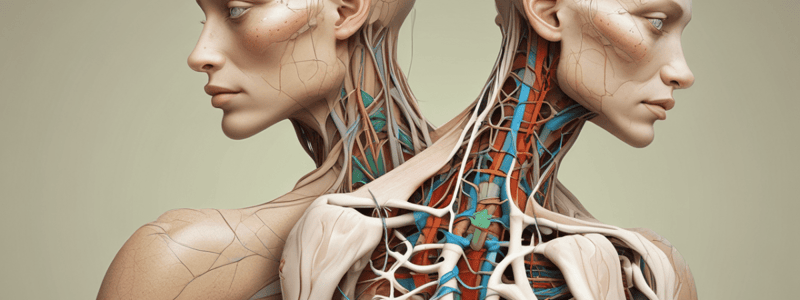Podcast
Questions and Answers
What should a nurse do before palpating a client's lymph nodes?
What should a nurse do before palpating a client's lymph nodes?
- Use the fingertips to apply heavy pressure
- Compare the right side to the left side simultaneously
- Ask the client if they have any pain or tenderness when touched (correct)
- Palpate the client's abdomen first
What is the primary reason for bilateral palpation of the lymph nodes?
What is the primary reason for bilateral palpation of the lymph nodes?
- To compare the size of the nodes
- To examine the nodes in a specific sequence
- To palpate all nodes simultaneously
- To detect any asymmetry or abnormalities (correct)
What is an essential aspect of palpating a client's lymph nodes?
What is an essential aspect of palpating a client's lymph nodes?
- Using heavy pressure to detect small nodes
- Palpating the nodes in a specific sequence
- Using the fingertips to apply gentle pressure
- Moving the fingers in a circular motion (correct)
What question might a nurse ask a client to assess their lymphatic system?
What question might a nurse ask a client to assess their lymphatic system?
What is an important characteristic to note when inspecting a client's hair?
What is an important characteristic to note when inspecting a client's hair?
What can cause thin and brittle hair?
What can cause thin and brittle hair?
What might a nurse ask a client to assess their skin during a lymphatic system assessment?
What might a nurse ask a client to assess their skin during a lymphatic system assessment?
What is a potential sign of severe protein deficiency?
What is a potential sign of severe protein deficiency?
Study Notes
Lymphatic System Assessment
- Palpation is used to assess the lymphatic system, and the nurse should inform the client to report any pain or tenderness during the process.
- Use the finger pads of two to three fingers, moving in a circular motion with light touch and gentle pressure, to avoid forcefully pushing the lymph node inwards.
- Palpate in one spot, then shift fingers to a new spot within the same area, as lymph nodes are present in strands throughout the area.
- Palpate bilaterally, comparing both sides, and ask the client about any pain or tenderness.
- Assess the body's ability to regulate fluid and waste, noting any swelling, lymphoedema, or cellulitis.
Client Assessment Questions
- When did the swelling start?
- Have you noticed any lymph nodes or lumps on your head, neck, underarms, or groin area?
- Have you noticed any changes in your skin?
- Do you have any chronic conditions or diseases that affect your lymphatic system?
- If yes, ask about other symptoms, particularly if noticeable lymph node changes or skin changes are present.
Hair Inspection Characteristics
Hair Characteristics
- Should be shiny, clean, and untangled
- Hypothyroidism can cause brittle, thin hair
- Distribution: Facial and body hair
- Color: Varies, with severe protein deficiency (Kwashiorkor) causing faded, reddish, or bleached hair
Studying That Suits You
Use AI to generate personalized quizzes and flashcards to suit your learning preferences.
Related Documents
Description
Learn how to use palpation to assess the lymphatic system, including the proper technique and considerations for the client's comfort. Understand the importance of palpation in this assessment.




